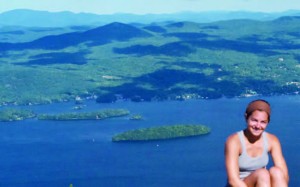MY INTERNSHIP DIDN’T BRING ME TO a distant country, nor did it introduce me to any prominent academics. Instead, I spent my summer working fifty hours per week, most of it doing intense physical labor—all with the goal of protecting ecological stability right here in the northeastern U.S.
In early 2010, I was hired as a SCUBA diver for Lycott Environmental Inc., an environmental consulting company in Southbridge, Massachusetts. Lycott is one of the oldest consulting companies in the region, and they are experts in aquatic weed control and management. My job was with the Integrated Aquatic Plant Management Program set in Lake George, New York.
Lake George, as well as most other large water bodies in the Adirondacks and across the country, is threatened by the invasive aquatic plant Eurasian Watermilfoil (Myriophyllum spicatum). The plant is known for its unique reproductive strategy and habitat preference that make it a threat to the ecological stability of freshwater systems. Eurasian Watermilfoil forms large, floating mats of vegetation that have been shown to lower dissolved oxygen levels, which can effectively reduce the diversity and richness of plant, macroinvertebrate, and fish assemblages. In addition to altering ecosystem function, Eurasian Watermilfoil interferes with recreation and aesthetics. Dense populations may even alter water flow and discharge, resulting in flooding and interference with industrial and municipal operations. Therefore, in addition to threatening the ecological stability of freshwater environments, Eurasian Watermilfoil is a threat to water bodies that are of essential use to humans.
It was my job to help in the management of this hearty plant in Lake George. However, before I could get in the water I prepared for the internship with an independent study led by Rich King, my supervisor and a Ph.D. candidate in Biology at Clark. Rich has been working for the Integrated Aquatic Plant Management Program since it began in 2002; a total of nine years of work put in to managing this one species in this one lake. He and I drew upon two essential texts in invasion biology literature: Elton’s The Ecology of Invasions by Animals and Plants and Davis’s Invasion Biology. The two texts are separated by fifty years of progress in the field, yet both provide the same overall viewpoint on invasive species: they are almost always unpredictable and difficult to manage.
In addition to the academic component, the job required training for SCUBA certification and a one-week observation period at Lake George. The certification training was stressful at times, but the most challenging was the one-week observation period at the lake. Early June may seem like the perfect time of year to spend on a lake nestled in the Adirondack Mountains, but this was anything but relaxing. Each ten-hour day on the lake was a combination of diving and moving materials. Half of the work is hand-harvesting, the process of picking plants from the substrate. The other half is what’s called benthic barrier installation and extraction. Benthic barrier is comprised of polyvinyl chloride (PVC) material cut to 7.5’x 50’ (350 ft2) panels weighing about 50 poundss each. The pieces are rolled over dense beds that are difficult to manage through hand-harvesting, and are secured to the substrate with rebar. Four to five weeks is sufficient time to kill all plants beneath the panel, at which time divers tie ropes to their ends and haul them out of the water.
Both hand harvesting and benthic barrier installation/extraction were physically demanding methods that required specific techniques in order to complete the task successfully. I quickly learned that the job was going to be both mentally and physically challenging, and that anyone willing to do this must be truly passionate about their work’s purpose. Although difficult, I came to enjoy the job and grew proud of what I was doing. I realized that helping the environment doesn’t require a Ph.D. or a high profile policy career; it simply requires a love and passion for what you do.
After nine years of Eurasian Watermilfoil management at Lake George, Lycott is beginning to see positive results. Many sites that were once dense beds haven’t seen milfoil growth in several years, and fewer new beds are being discovered each year. Their long-term efforts and dedication to the project have paid off, and shows how it really only takes passion and perseverance to make positive changes for our environment.
While I won’t be returning to Lake George next summer, the experience and training I gained during the internship will most definitely help kick start my career. I’m eager to apply my diving skills to help solve more environmental issues.
Happy diving,
Erin
This article originally appeared in the 2010 issue of News & Views, IDCE’s departmental annual review.


